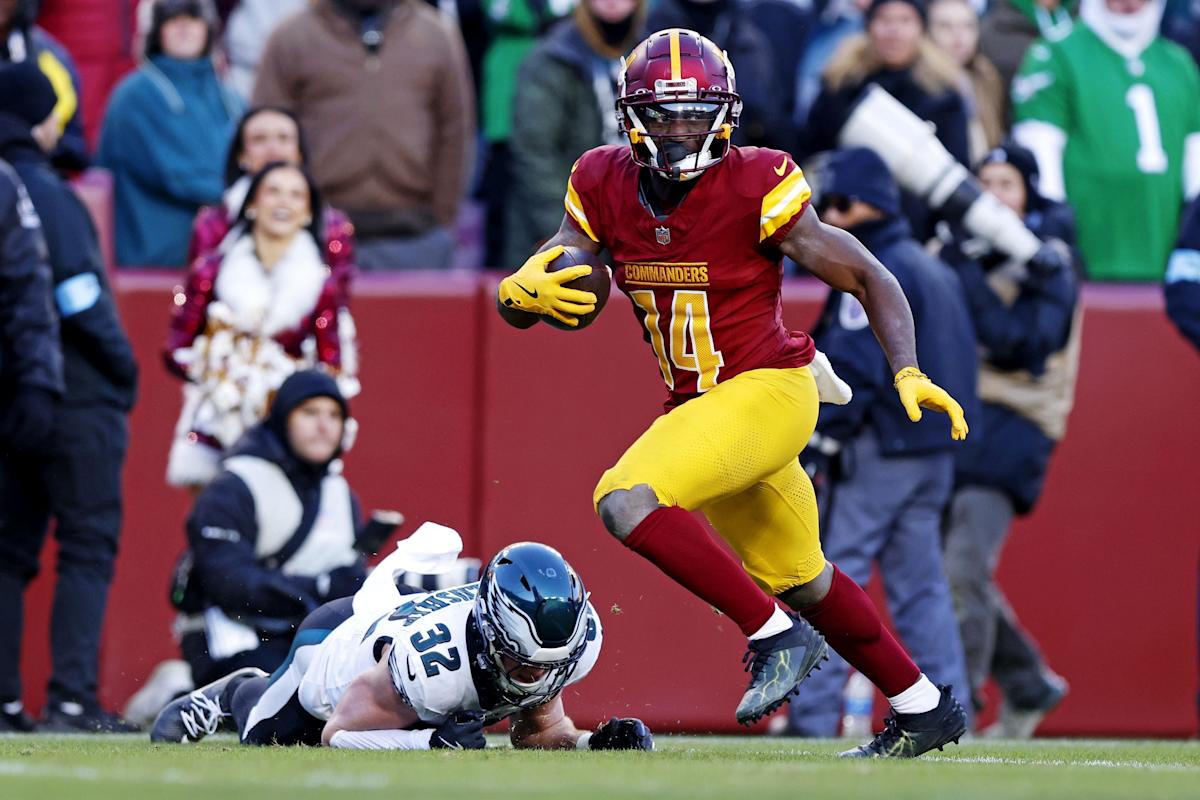Evaluating Devin Duvernay and Olamide Zaccheaus, the Bears’ new acquisitions
In the fast-moving world of the NFL, rosters undergo significant transformations every offseason as teams aim to improve their chances of success in the coming season. The Chicago Bears, entering a new chapter in their rebuilding process under head coach Matt Eberflus and general manager Ryan Poles, have been active in the offseason to fortify their roster, particularly the wide receiver position, which has been a major area of concern for the team in recent seasons. Among the more intriguing acquisitions for the Bears are wide receivers Devin Duvernay and Olamide Zaccheaus. Both players come with promising resumes and unique skill sets that could help elevate the Bears’ offense. This in-depth evaluation aims to break down their potential fit with the Bears, analyzing their career trajectories, playing styles, and how they can contribute to the team’s success.
Devin Duvernay: A Dynamic Weapon with Untapped Potential
Devin Duvernay, a third-round pick by the Baltimore Ravens in 2020, brings to the table a blend of speed, explosiveness, and versatility. Throughout his career, Duvernay has showcased flashes of brilliance but has yet to fully cement himself as a consistent top-tier receiving option. However, his background as a playmaker and his potential to grow within a more pass-oriented offense make him an exciting addition for the Bears.
Strengths and Skill Set
Duvernay is primarily known for his speed and agility, making him a dangerous weapon after the catch. Standing at 5’11” and weighing 200 pounds, he has a compact frame that allows him to make quick cuts and accelerate rapidly. One of his most notable skills is his ability to turn short passes into explosive plays, thanks to his after-the-catch elusiveness. In an offense that values yards gained after the catch (YAC), Duvernay can excel by providing a quick release and creating big plays out of short routes.
His performance in the return game is another strength that shouldn’t be overlooked. Duvernay has been a dynamic returner for the Ravens, showcasing his ability to change the game with his explosiveness on special teams. His return prowess adds value beyond just being a wide receiver, especially for a Bears team looking to improve in all areas of the game.
In terms of route running, Duvernay has solid fundamentals but can still improve in terms of refining his technique. While he isn’t known for running complex routes, he has shown the ability to get open on quick-hitting slants, drag routes, and go routes. His deep-threat ability is a plus, especially with his 4.39-second 40-yard dash time, and he could stretch defenses by threatening to blow past defenders on deep routes, creating space for other players on the field.
Concerns and Areas for Growth
While Duvernay has flashed potential, he has yet to establish himself as a consistent and reliable target. Over his first three seasons in the NFL, Duvernay has been primarily used in a limited role, often as a secondary option behind stars like Mark Andrews and Hollywood Brown. His career high in receiving yards was 407 in 2021, a number that reflects both his lack of opportunity and perhaps the limitations of the Ravens’ offense, which has been more run-heavy and not as reliant on wide receivers as many other teams in the league.
In addition, Duvernay’s catch radius and ball skills could use some refinement. While he is an athletic receiver with good hands, he can occasionally struggle with contested catches and doesn’t have the best tracking skills on deeper throws. As a result, his ability to win 50-50 balls is something that may need to be developed further in the right system. His lack of size and elite jump-ball skills also mean he may struggle when matched up against larger, more physical cornerbacks on the outside.
Lastly, Duvernay’s transition from a team with a run-heavy offense like the Ravens to a Bears offense that is still working to find its identity could present some challenges. While the Bears are trying to become more pass-oriented, it’s unclear if Duvernay will have the volume of opportunities necessary to truly shine as a top target.
Potential Role with the Bears
With the Bears, Duvernay has the opportunity to step into a more significant role within the offense. The Bears have a developing young quarterback in Justin Fields, whose skill set is well-suited to take advantage of a wide receiver like Duvernay. Fields’ mobility and ability to extend plays with his legs will open up opportunities for Duvernay on designed rollouts, quick slants, and screens where his speed and YAC ability can make a major impact. The Bears will likely use Duvernay in the slot, where his quickness and route-running ability on shorter routes can shine, as well as on deep balls to stretch the field vertically.
While Duvernay may not emerge as a No. 1 receiver immediately, he can provide an important complementary role on the offense, offering a deep-threat option and a weapon who can contribute in the return game. With more touches and a more pass-oriented offensive system, Duvernay could have the opportunity to develop into a key contributor for the Bears.
Olamide Zaccheaus: A Reliable and Smooth Route-Runner
Olamide Zaccheaus, who most recently played for the Atlanta Falcons, is another intriguing acquisition for the Bears. Zaccheaus is a receiver known for his crisp route-running, reliability, and ability to create separation at all levels of the field. While he is not as physically gifted as some other receivers in terms of raw athleticism, his skills as a technician make him a valuable asset for any offense looking for a polished wide receiver to move the chains and create opportunities in the passing game.
Strengths and Skill Set
Zaccheaus’ most notable trait is his route-running ability. Standing at 5’8″ and weighing 183 pounds, Zaccheaus is often undersized compared to many of his NFL peers, but he compensates with excellent technique and a high football IQ. He excels at creating separation through his ability to read defensive coverages and adjust his routes accordingly. This makes him particularly dangerous in intermediate and short routes, where his sharp cuts and understanding of leverage allow him to get open quickly. His strong fundamentals as a route runner give him the ability to make defenders miss in one-on-one situations and be an option for quick throws.
Zaccheaus has also been reliable in terms of catching the football. Over the course of his career, he has proven to be a safe pair of hands, with a career catch rate of nearly 70%. He’s not a player known for making spectacular catches, but he is dependable and can be counted on to haul in the routine receptions needed to keep the chains moving. Zaccheaus also has a solid ability to work underneath, making him an ideal candidate to operate in the slot or on quick, intermediate routes where he can use his agility to exploit soft spots in the defense.
One of Zaccheaus’ other strengths is his ability to function in various offensive schemes. While with the Falcons, he operated both outside and in the slot, which provides versatility to the Bears’ receiving corps. This flexibility allows him to be plugged into various formations and provide Justin Fields with a consistent option in the passing game, whether in third-down situations or as a chain-mover on early downs.
Concerns and Areas for Growth
Despite his reliability, Zaccheaus is not a dynamic playmaker in the sense that he doesn’t have the breakaway speed of other wide receivers. While he can make defenders miss in space, he is not someone who is going to routinely take the top off a defense with explosive plays. His lack of elite speed (4.44-second 40-yard dash) may limit his ability to make huge gains on vertical routes, and while he’s an excellent route runner, he lacks the physicality to win consistently against larger cornerbacks in contested catch situations.
In addition, Zaccheaus’ role in Atlanta was often as a complementary receiver rather than the primary option. He was never the focal point of the offense, which could raise questions about how well he will perform when asked to take on a larger role in Chicago’s offense. The Bears’ receiving corps is still developing, and Zaccheaus will likely have to prove that he can step up as a more consistent, reliable target for Fields on a regular basis.
Potential Role with the Bears
Zaccheaus is a natural fit for the slot position, where his precise route running and quickness can shine. He could emerge as a key security blanket for Fields, particularly on short-to-medium routes like slants, out routes, and option routes. Zaccheaus’ ability to get open quickly and reliably could make him a go-to option on third downs, where his sure hands and ability to move the chains will be invaluable.
Additionally, Zaccheaus’ experience in a balanced offense in Atlanta, combined with his work in various roles, gives him the versatility to move around the formation. He could play both outside and inside, depending on the matchups and offensive scheme, giving the Bears flexibility in their offensive play-calling.
While Zaccheaus may not be a game-changing superstar, he could become a dependable and consistent contributor in the Bears’ offense. His professionalism, route-running ability, and dependability will make him a trusted asset for Fields as the quarterback looks for options who can consistently move the chains.
The Chicago Bears’ acquisitions of Devin Duvernay and Olamide Zaccheaus should bring added depth and versatility to their wide receiver group. Duvernay’s explosive speed and ability to make plays after the catch provide a dynamic element to the offense, while Zaccheaus’ polished route running and reliability give the team a solid and dependable target. While both players have areas in which they can improve, they bring distinct qualities that can complement each other and help elevate the Bears’ offensive attack.
For the Bears, a team that is looking to establish an identity and build around Justin Fields, Duvernay and Zaccheaus offer an intriguing combination of upside and stability. Duvernay could develop into a key deep threat and big-play player, while Zaccheaus can provide consistency and a reliable set of hands in critical situations. Together, they will give the Bears more options as they look to develop an offense that can support Fields and take the next step toward contention.



